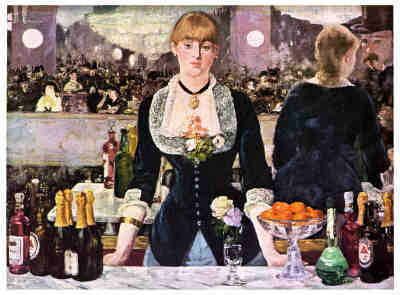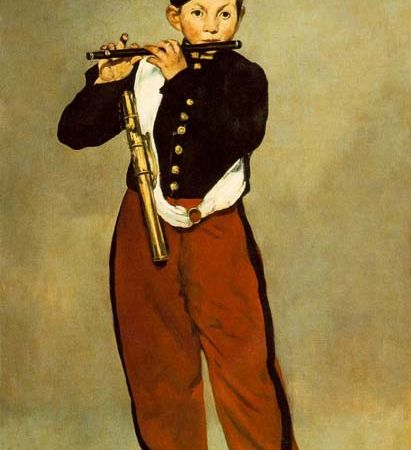Edouard Manet is often identified with the "Impressionists," and was
influenced by them. However, because of the Paris art world's generally
hostile regard for "Impressionism," he chose not to exhibit with them. He
preferred to show his work in the more conservative exhibitions sponsored
by the French government.
Manet learned to paint in the traditional style, but his work became more
spontaneous after his exposure to Claude Monet and the other
"Impressionists." He used expressive outline, severe lighting contrasts,
bold color and rich texture to portray the world around him.

Manet scandalized the people of Paris with a number of works containing
nudes painted in bold poses with direct, outward gazes. While it was
popular during his time to paint scenes from the Bible and ancient
history, Manet painted scenes from 19th Century history, including one
work featuring the execution of Emperor Maximillian of Mexico in 1867.
Manet began to paint genre (everyday) subjects, such as old beggars,
street urchins, cafe characters, and Spanish bullfight scenes. He adopted
a direct, bold brush technique in his treatment of realistic subject
matter.
In 1866 the French novelist Emile Zola, who championed the art of Manet in
the newspaper Figaro, became a close friend of the painter. He was soon
joined by the young group of French impressionist painters, Edgar Degas,
Claude Monet, Auguste Renoir, Alfred Sisley, Camille Pissarro, and Paul
Cezanne, who were influenced by Manet's art and who, in turn, influenced
him, particularly in the use of lighter colors and an emphasis on the
effects of light. Manet served as an officer in the French army from 1870
to 1871, during the Franco-Prussian War. In 1882 one of his finest
pictures, The Bar at the Folies-Bergere (Courtauld Institute and
Galleries, London), was exhibited at the Salon and an old friend, who was
then minister of fine arts, obtained the Legion of Honor for the artist.
Manet died in Paris on April 30, 1883. He left, besides many watercolors
and pastels, 420 oil paintings.

In 1863 his famous Le dejeuner sur l'herbe (Muse d'Orsay, Paris) was
shown at the Salon des Refuses, a new exhibition place opened by Napoleon
III following the protests of artists rejected at the official Salon.
Manet's canvas, portraying a woodland picnic that included a seated female
nude attended by two fully dressed young men, attracted immediate and wide
attention, but was bitterly attacked by the critics. Hailed by young
painters as their leader, Manet became the central figure in the dispute
between the academic and rebellious art factions of his time. In 1864 the
official Salon accepted two of his paintings, in 1865 he exhibited his
Olympia (1863, Musee d'Orsay), a nude based on a Venus by Titian, which
aroused storms of protest in academic circles because of its unorthodox
realism.


































